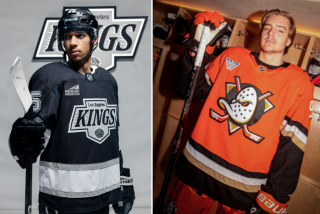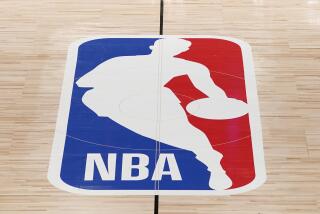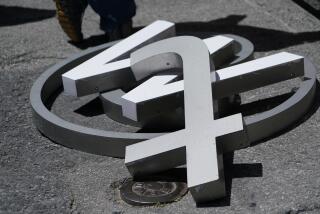THEY’RE EXPENSIVE, MOST DON’T LAST. BUT CORPORATE AMERICA, HOT TO CONVEY AN IMAGE IN AN INSTANT, IS. . . : Loco Over Logos
- Share via
When pop legend and world-class eccentric Prince decided that “Prince” no longer held sufficient intrigue, he didn’t just change his name. He changed his name to a logo: ***
As it happens, was not out to lunch but, in his ***ly way, was merely fulfilling the manifest destiny of ‘90s culture: replace the literal withthe symbolic, the verbal with the visual.
“We are truly bombarded by images,” says commercial-art titan Saul Bass, designer of the United Airlines, Alcoa and AT&T; logos. “To break through and be observed, let alone focused on, you have to have impact and power.”
In other words: a bodacious logo.
Does it work? Just ask ***, whose logo, while cementing a reputation for career vagaries, at least caused his detractors to pay attention again. (William Jefferson Clinton, are you listening?)
IT’S NEW! IT’S IMPROVED! IT’S INCREDIBLY EXPENSIVE!
Like an eye-tuck by a Beverly Hills plastic surgeon, corporate face lifts inevitably sag. Fifteen to 20 years is the typical logo life span, estimates Keith Bright of Bright & Associates, designers of the Ryder rental-truck trademark. New ones aren’t exactly cheap. Bright says a complete corporate-identity overhaul, like those recently launched by Federal Express, the U.S. Postal Service and Best Western hotels, can cost half a million dollarsin design fees before a single truck, plane or “Do Not Disturb” sign gets a boss new look. The total cost can easily dwarf John Travolta’s post-”Pulp Fiction” asking price: Federal Express spokesman Thomas R. Martininsists that the company spent “far less than $5 million” on its new “FedEx” make-over, which could take three years to complete and involve 458 aircraft, 31,000 vehicles and tens of thousands of drop boxes.
Why bother? “Our vehicles are essentially moving billboards, and nobody would have the same billboard up for 20 years,” Martin says, adding that Federal Express estimates all those double-parked vans provide the equivalent of $160 million in outdoor advertising. Absolutely, positively . . . a bargain?
MAKE IT, Y’KNOW, CLASSIC
Hollywood studios have joined such corporate visionaries as Coca-Cola, Esquire and Life by commissioning genetically engineered, postmodernized versions of their earlier logos--and spending, by some estimates, between $500,000 and$1 million a pop. “It’s kind of revivalist, bringing modern technology to bear on an image that was created in the early days of the studios,” acknowledges Steve Soffer, whose Studio Productions in Hollywood has performed high-tech resuscitations of antique Universal, Paramount and 20th Century Fox logos.
God, or somebody, is clearly in the details: Universal’s was made over using a 3-D plaster globe with hammered copper continents (a National Geographiccartographer supervised) and photographed using a computer-controlled 65mm camera. Paramount’s features a scale-model mountain planted with 15,000 trees and garnished with computer-generated graphics. The Fox monolith, introduced in 1934, has been digitally animated into a 21-second curtain-raiser complete with a re-recorded “Fox fanfare.” Meanwhile, Sony’s Columbia Pictures tarted up its venerable Gem-of-the-Ocean lady and plunked her on a pedestal before cumulonimbus clouds. Sister studio TriStar Pictures’ winged horse, introduced in the ‘80s but conceptually dating to June Cleaver’s pearls, suggests Pegasus on Prozac. Coming soon:a born-again Citizen Kane-era RKO Pictures logo, complete with radio tower, lightning-bolt letters and beeping Morse code SFX.
The point of all this demi-nostalgia? Evoke a “romanticized, revisionist history,” says Bass. “When people were sensible, nobody lied and Mom was at home.”
REQUIESCAT IN PACE
A recalcitrant union here, a terrorist bombing there, and suddenly a venerable airline, along with its logo, is pushing up daisies. New Yorkers mourned when Pan Am’s landmark neon trademark and globes, installed atop its Park Avenue headquarters in 1963, were replaced two years ago by building owner Metropolitan Life’s prosaic signage. Eastern’s snazzy, stylized-airplane trademark, introduced at the dawn of the jet age--”thefirst decent airline logo,” notes Bright--still looked bitchin’ when the carrier went bust in 1991, especially when compared to the marques of surviving carriers like Southwest, whose suburban-S&L-style; logo and earth-tonedplanes evoke nothing so much as Burbank during a Santa Ana.
THE CLASSICS
They have, with only minor tweaking or none at all, survived stock market crashes, world wars, the death of vaudeville and possibly the advent of Newt Gingrich. Among them: Coca-Cola, Arm & Hammer and Lucky Strike. What makes a logo classic? “It takes simplicity and a design that’s really well done,” says Bright. Bass invokes the mighty Mercedes trademark used by Daimler-Benz since 1909. “It’s amazing. It has a coherence that transcends time. It could have been designed five years ago.”
LEGGO MY LOGO
1. You’re NBC. You’ve just spent $750,000 on a nifty new “N” logo guaranteed to thrill the rustics in Omaha. Only problem: one of said rustics, the Nebraska Educational Television Network, has already designed and been using practically the same logo, minus focus groups, market research and big fees. NETV drags you to court, claiming trademark infringement. Solution: Give them $500,000 worth of TV equipment and pay $55,000 to NETV to design another logo. Epilogue: Nine years later, junk your masterpiece and bring back the daffy peacock you’d been using since 1956. (Amazing trivia: Each of the peacock’s six feathers symbolizes an NBC division--News, Sports, Entertainment, Stations, Network and Operations; the NBC tones are the notes G, E and C, for General Electric Corp., the network’s once-and-later-to-be-vilified-by-Letterman corporate parent.)
2. You’re Procter & Gamble. In the early ‘80s and again in the ‘90s, your 1882-vintage trademark--a man in the moon squinting paternally at 13 stars representing the original colonies--is tarnished by rumors that it is a satanic rune, thus requiring some users of P&G;’s Crest to undergo a lengthy and bothersome exorcism after brushing. You strive mightily to scotch the stories, which usually include a bonus fable about the president of P&G; discussing satanism on the Merv Griffin or Phil Donahue shows. Despite successful lawsuits against rumormongers and a barrage oftestimonials from Donahue, Griffin’s production company and various clergy discrediting the stories, imagined linkages between Ivory soap and the Antichrist persist. Solution: You withdraw the moon-and-stars from most productsand plead for sanity. “I would appreciate it if you would emphasize that any relation to satanism and this trademark is completely false,” sighs P&G; representative Elaine Matthews. “It’s beyond me how anyone could believe something like that.”
LOGO A-GO-GO
Who’d have thought skateboard culture could be more than an oxymoron? Turns out that skate rats, in between piercing every one of their orifices and terrorizing pedestrians, developed a hankering for customizing well-known logos with their own, as Butt-head calls them, “words-words-words.” Punk rockers and snowboarders followed suit. Alas, corporate killjoys have gone after the nascent Warhols with injunctions--Ford slapped a clothing maker with a cease-and-desist order for refashioning its script logo into a version of an equally familiar f-word, thus impeding a potential Pop art renaissance. Endless bummer!
More to Read
Inside the business of entertainment
The Wide Shot brings you news, analysis and insights on everything from streaming wars to production — and what it all means for the future.
You may occasionally receive promotional content from the Los Angeles Times.










